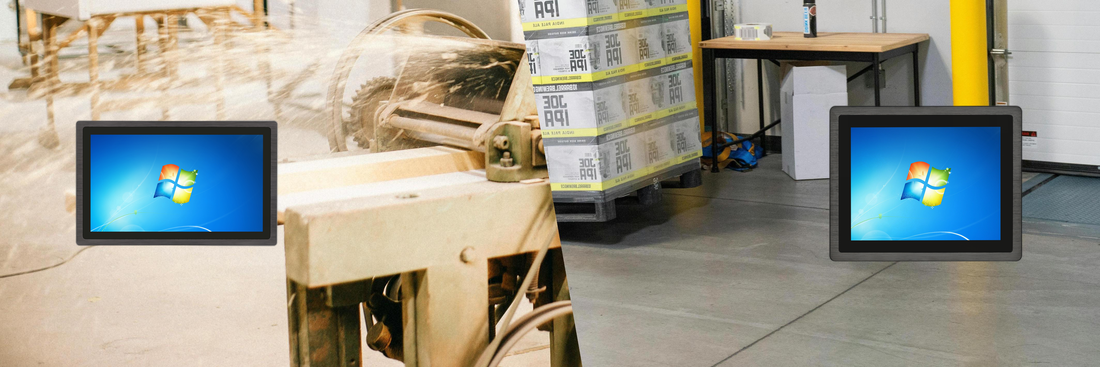
Extreme Heat Resilience: The Role of Wide Temperature Industrial PCs in Harsh Environments
Extreme Heat Resilience: The Role of Wide Temperature Industrial PCs in Harsh Environments
In today's rapidly advancing industrial landscape, computers have evolved to meet the ever-growing demands of challenging environments. One particular type of computer designed for such settings is the heat-resistant computer, built to perform optimally across a broad range of temperatures. From freezing cold to scorching heat, these machines ensure seamless operations even when the environment around them is anything but forgiving.
Understanding Heat Resistant Computers
A heat-resistant computer is engineered to maintain performance stability even in harsh conditions, including exposure to dust, water, vibration, and extreme heat or cold. These computers are tailored for industries that require reliable computing power in environments that are far from the controlled settings of a typical office. With temperature tolerance ranging from as low as –40°C to as high as 70°C, these machines are crucial in sectors such as oil and gas, industrial automation, and outdoor installations.
These computers are more than just rugged on the outside. Internally, they are equipped with advanced thermal management systems to prevent overheating and maintain performance integrity. Understanding how these machines handle extreme temperatures requires a grasp of some fundamental concepts, which we'll explore further.
The Science Behind Heat Generation in Computers
Before delving into the specifics of heat-resistant computers, it’s important to understand how heat is generated in conventional systems. Key concepts include:
- Thermal Design Power (TDP): TDP refers to the maximum amount of heat a CPU is expected to produce when running under full load. This metric helps engineers design the computer's cooling solution appropriately. Typically measured in watts, a high TDP indicates more power consumption and heat generation, necessitating advanced cooling systems.
- T-Junction: This represents the highest temperature a CPU can reach before it starts to reduce its performance, entering a phase known as thermal throttling. If the CPU approaches its T-Junction limit without adequate cooling, it will slow down to avoid permanent damage.
- Thermal Throttling: This is the process by which a CPU automatically reduces its performance to prevent overheating. While this helps protect the hardware, it also means a significant drop in processing efficiency.
By understanding these fundamentals, it becomes clear that managing heat within a computer—especially in extreme environments—is a complex task. Without adequate thermal management, even the most advanced processors can overheat and suffer from performance degradation.
Why Do Computers Overheat?
Computers generate heat primarily because of the electrical flow within their components. Among all the parts, the CPU is the primary heat generator. The more powerful the processor, the more heat it will generate. For instance, consumer-grade CPUs in desktops typically produce up to 130 watts of thermal power under heavy load. Workstations with even more demanding requirements can generate up to 200 watts of heat.
However, industrial-grade heat-resistant computers are built differently. They often operate within a more controlled TDP range of around 10 to 65 watts, ensuring they can run reliably without requiring complex, failure-prone cooling mechanisms. This lower TDP makes it possible to implement fanless designs—a key feature of most industrial heat-resistant computers.
The Drawbacks of Traditional Cooling Systems
In conventional systems, overheating is often caused by two primary factors:
- Poor thermal design: When a computer's cooling solution isn't matched properly to its TDP, even moderate tasks can cause it to overheat. This is common in consumer-grade systems with inadequate heatsinks or improperly configured fans.
- Blocked cooling fans: Dust, dirt, and other debris can clog fans, reducing airflow and making it difficult for the system to expel heat effectively. Over time, this leads to component failure.
Industrial-grade computers avoid these issues by utilizing fanless cooling systems. These systems use passive cooling methods such as heatsinks and conductive materials like copper and aluminum to dissipate heat. Without fans, there’s no risk of clogging, and the machines are more resistant to shock and vibration—making them perfect for harsh environments.
How Heat-Resistant Computers Work
Industrial heat-resistant computers use innovative cooling designs to maintain their performance in extreme environments. The fanless cooling design is central to this. These systems rely on ultra-conductive heatsinks made from metals like aluminum and copper to draw heat away from critical components such as the CPU and platform controller hub (PCH).
The heatsinks channel this heat to the external chassis, which is constructed from extruded aluminum or other heavy-duty materials. This design allows the heat to dissipate over a larger surface area, keeping internal temperatures manageable even when external conditions are harsh.
Incorporating heat pipes further improves thermal dissipation. These pipes, often made from copper, transfer heat more efficiently from hot spots to cooler areas, ensuring even temperature distribution throughout the system. This advanced thermal design allows heat-resistant computers to function reliably in environments where conventional systems would fail.
Testing the Limits: Ensuring Reliability
To ensure reliability, manufacturers of heat-resistant computers, such as IMDTouch, conduct rigorous testing. These tests simulate the real-world conditions that the computers will face in their deployment environments. For example, temperature and humidity chambers test the machines' tolerance to both heat and moisture. Multi-axis vibration tables assess how well the systems can endure constant physical disturbances.
Advanced equipment, like thermal shock chambers and EMI signal integrity testing tools, push the computers to their limits. These tests ensure that the machines meet the industrial-grade standards required for sectors such as transportation, smart cities, and outdoor kiosks.
Applications for Heat-Resistant Computers
Heat-resistant computers are critical in industries that operate in extreme environments. Some of the key applications include:
- Industrial Automation: Factories with high-heat processes require computers that can tolerate extreme temperatures while maintaining precision control over machinery.
- Remote Oil and Gas Monitoring: These systems need to function reliably in remote locations with fluctuating and often extreme temperatures.
- Outdoor Smart City Infrastructure: Heat-resistant computers are deployed in smart city applications like traffic monitoring systems and public kiosks, where exposure to outdoor temperatures can be extreme.
- Vehicle Telematics: In transportation, heat-resistant computers power navigation, diagnostics, and communication systems, even when vehicles operate in desert-like conditions.
- Smart Agriculture: Farmers rely on robust computers to manage IoT systems in agriculture, ensuring that their operations continue even in extreme heat or cold.
Frequently Asked Questions
How can I cool down my computer?
Improving the cooling system or reducing the processing load can help. Cleaning fans, applying thermal paste, and closing heavy applications can significantly reduce overheating. For industrial-grade systems, however, adopting a fanless design eliminates the need for constant fan cleaning and maintenance.
What temperature is too hot for a CPU?
Generally, CPU temperatures between 70°C and 80°C are safe for most applications. However, consistent operation above 90°C can lead to permanent damage over time.
How hot can a CPU get without a heatsink?
A CPU without a heatsink can overheat rapidly, easily reaching temperatures above 100°C, which can cause immediate damage if not addressed.
IMDTouch specializes in designing and manufacturing industrial-grade, heat-resistant computers optimized for extreme environments. For further details or inquiries, visit www.IMDTouch.com or contact support@IMDTouch.com. Whether it's remote monitoring or industrial automation, our systems are built to withstand the toughest conditions while delivering reliable performance.
